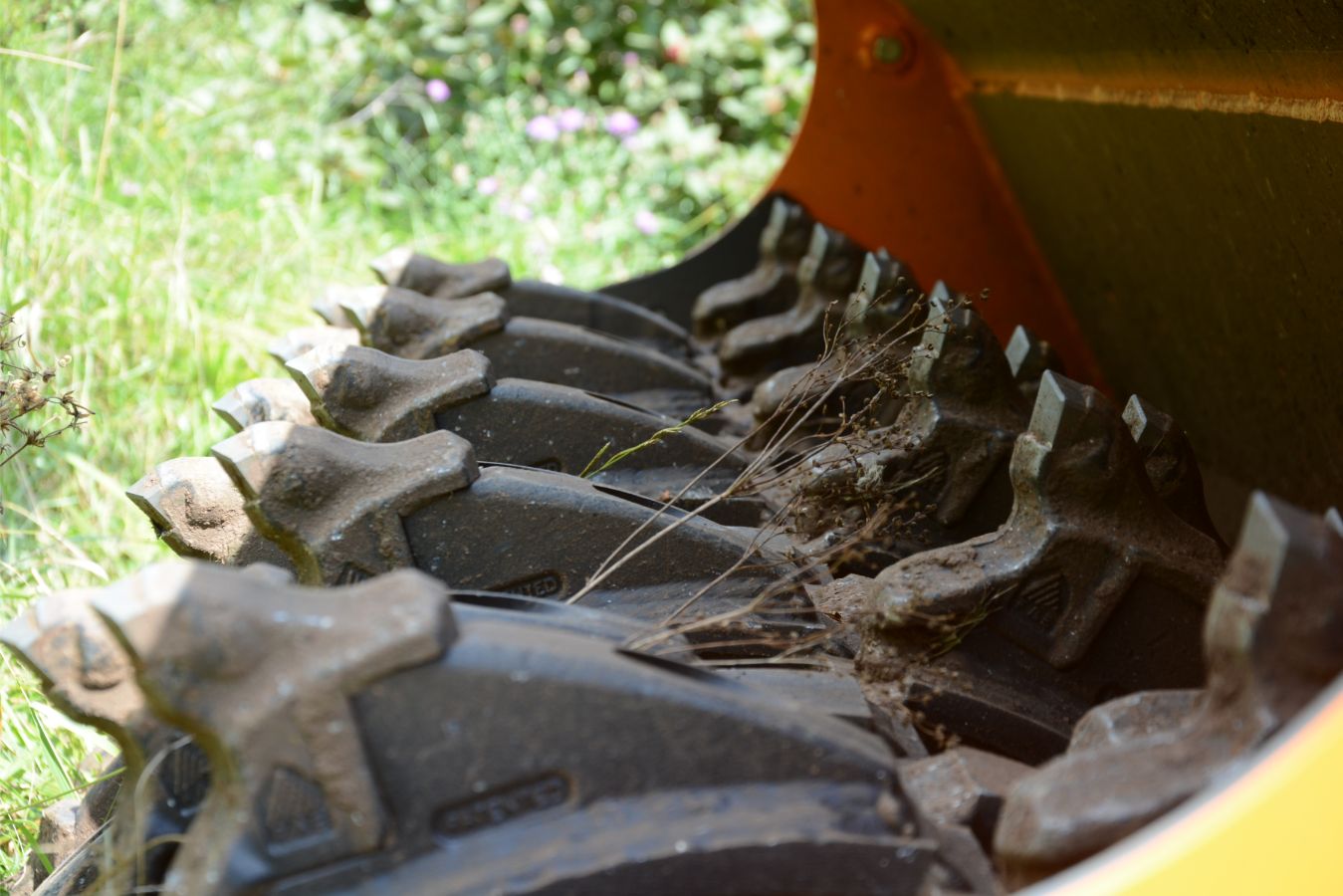Abstract
Spanish residual ERW contamination response is analyzed for statistical trends.
Initial assessment appears to show random distribution, but statistical evaluation clearly demonstrates the same trends are present in Spain as in other ERW affected countries. Cumulative data tapering implies a gradual decrease in ERW recovery rates over time. Accurate modeling resulting from comprehensive data collection can inform more targeted policies. Evaluations of other data sets could validate the methodology or point towards helpful modifications of the model.
Introduction
Previous work on Residual Contamination has focused on the development and evolution of risk management practices concerning Explosive Remnants of War in European countries affected by the First and Second World Wars, in comparison to more recent conflict zones, such as Cambodia, Lao PDR and Vietnam. Other work has looked at legislative development and national capacities in countries such as Mali, Nepal and Nicaragua.
Absent in this discussion has been the impact and subsequent development resulting from the Spanish Civil War. Characterized by significant involvement by foreign powers in terms of munitions supply, the story has remained largely untold due to reticence in the population to engage with the topic.
This has only recently begun to change. With the publishing of various accounts and the writing of specific works there has also been an increase in news articles published on the topic] These articles have primarily been a result of Freedom of Information (FOI) requests. The results of this paper are a consequence of one of these requests.
Background on Evolution of EOD Response
Without doing the topic justice, some background information is still helpful. The Spanish Civil War began as a military coup by General Franco. In an effort to return to more traditional values of Church and King, General Franco gathered like-minded officers in a revolt. This was launched from the Canary Islands, where Franco was essentially exiled, and swiftly moved north through the Iberian Peninsula. General Franco met significant resistance in Madrid, and sought to cut Madrid’s lifeline – the connection to the port of Valencia. The Republican Army tried to avoid the destruction of Valencia in a battle by engaging General Franco’s troops in the rugged terrain 250 kilometers to the north.
Figure 1: Innovations in artillery and aircraft bombing where tested during the Spanish Civil War
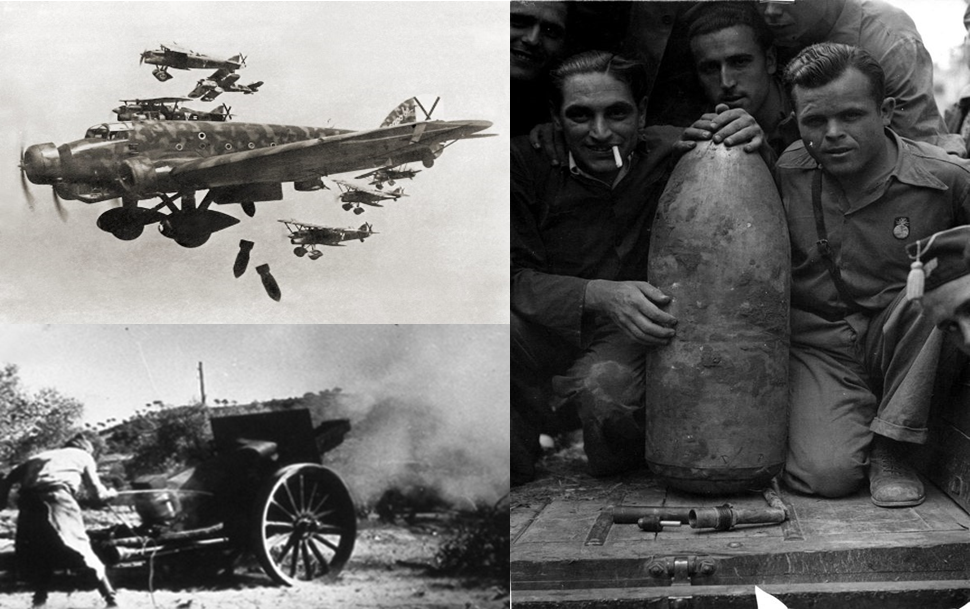
Terra Alta and the banks of the Ebro River were the site of intense fighting toward the end of the Spanish Civil War. The battle here proved decisive in the outcome of the war, as the Republican Army staked almost all its resources, counting on international support. This support never came, based on a non-intervention agreements and promises made at the international level. While all sides found ways to remain involved, whether selling rubber, food or munitions, Germany and Italy, under the rule of Hitler and Mussolini respectively, contributed significantly to the cause of General Franco.
Barcelona was not untouched, having been subjected to extensive air raids launched by Italian forces on the island of Menorca. Each Barcelona neighborhood collaborated to build bomb shelters as refuge against some of the first air attacks against a civilian population
Figure 2: Classified Italian orders to bomb Barcelona city center.
Figure 3: A Barcelona community bomb shelter, staircase leading down
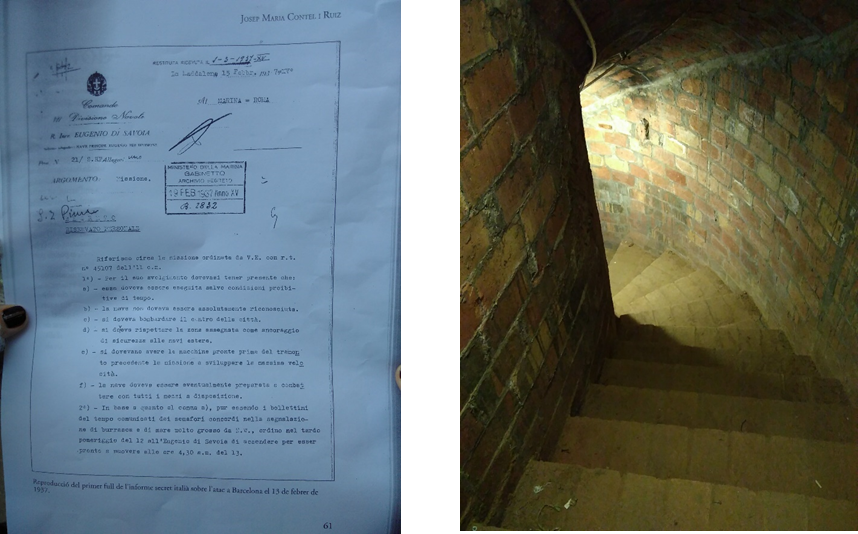
Figures 4 and 5: Notices to citizens on appropriate action to take during a bombardment
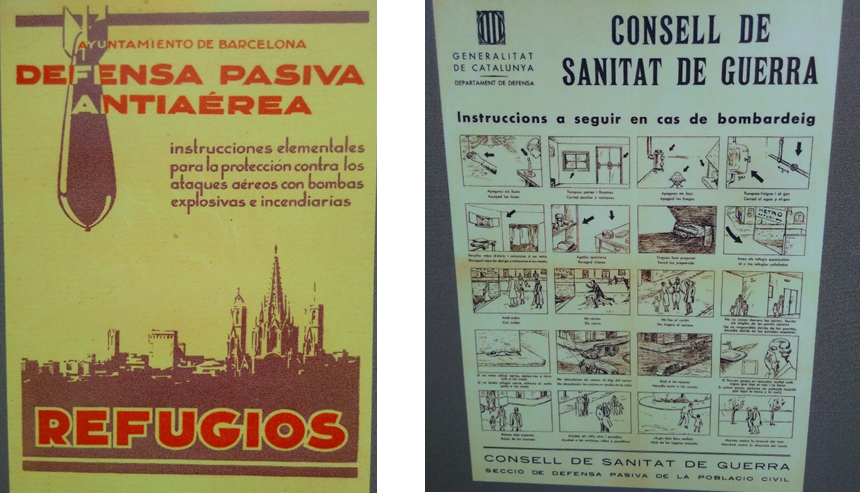
The munitions, which remain scattered on the ground in the northeastern part of Spain, remained untouched unless recovered and dismantled by a growing cadre of self-taught bomb disposal amateurs. Destroyed crops, infrastructure and homes made metal recycling one of the few sources of income for populations in the affected rural area of Terra Alta. Accurate counts of the total number of munitions destroyed and number of casualties consequent to a school of trial and error in this period are not available. Those that survived passed on their hard-earned knowledge to fellow workers.
One such disposal worker, Pere Sanz, has established a visitor center called “La Trinxera” (The Trench) which documents in significant detail the work undertaken by the group of self-taught deminers.
Figure 6: Pere Sanz, Owner, Exposición Guerra Civil La Trinxera

Official bomb disposal was originally the work of the military and then the Guardia Civil (Civil Guard). Under General Order of March 2nd, 1970, the Spanish government created the technical specialty for EOD and established what is now called Servicio de Desactivación de Explosivos (SEDEX).It has been adapted several times, including in 1979, 1988, 2000, and 2004. These structural and legislative changes consequently increased the remit of SEDEX to include Nuclear, Radiological, Biological, and Chemical (NBRQ) artifacts.
SEDEX, the central authority, is complemented by the Grupos de Especialistas en Desactivación de Artefactos Explosivos y de naturaleza NRBQ (GEDEX), which exists on the provincial level and houses EOD experts who respond to ERW discoveries.
In general, the use of metal detectors is covered by international conventions such as European directive 921 of 1981, and the Convention of Malta 1992. Spanish law Ley 16/1985, de 25 de junio, del Patrimonio Histórico Español (on Spanish Historical Heritage) penalizes the disturbance of heritage sites or objects and mandates reporting the discovery of anything over 200 years old.[The only place in Spain with a unilateral ban on metal detection is Sevilla (Seville), where a permit is required.
Of interest to amateur treasure hunters in Northeastern Spain (mainly Catalonia), is a recent law that has prohibited the use of metal detectors without a permit which authorizes the searcher to explore a specific place for a specific time. The intent is to protect archeological heritage sites from being disturbed. The result, per discussions with amateurs who wish to remain anonymous, is that many activities are now pursued illegally. To avoid detection, searches are often conducted at night. This increases the risk borne by these searchers of inadvertently injuring themselves when an item of residual ERW is discovered.
In an interview in December, 2016, Pere Sanz discussed how he learned from previous experts, and how the dire poverty following the end of the Civil War forced many farmers to resort to the scrap metal trade to feed their families. He also commented on the changing regulations regarding the use of metal detectors
Problem Statement
Research Papers, Concept Notes, Issue Briefs and a Documentary Film have all recently been published considering the evolution of the risk management response to Residual ERW contamination. Discussions consequent to these publications have illuminated a common trend of exponential decline in the frequency of ERW discoveries per year. The data behind these discussions have not been comprehensive, nor have they been published. This paper seeks to publish the existing discourse on tapering-off and to encourage data sharing. What lessons can be drawn from the evolution of the Spanish response?
Methods
The research focused on the data per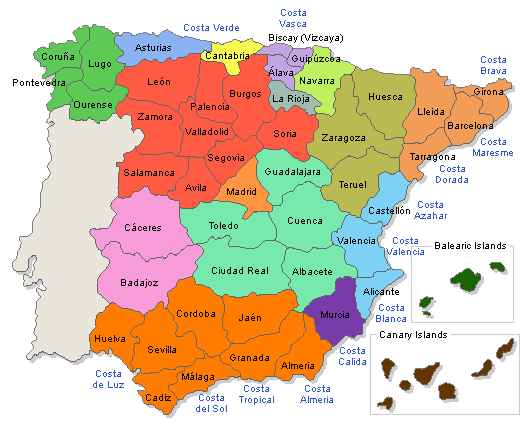 taining specifically to the battle of the Ebro Valley, due to its decisive impact on the eventual outcome of the war, the significant involvement of foreign troops, and the use of the “baby brigades” (young soldiers) along with deployment of air power.
taining specifically to the battle of the Ebro Valley, due to its decisive impact on the eventual outcome of the war, the significant involvement of foreign troops, and the use of the “baby brigades” (young soldiers) along with deployment of air power.
The authors submitted a Freedom of Information Request to the Spanish Government (General Administration of the Civil Guard, Madrid) for data pertaining to the research question above.The response was received by post several weeks later.
The data supplied exceed the scope of the original question, encompassing data from Lleida, Zaragoza and Tarragona (see map). The analysis has therefore been expanded to consider these data as well. The data set from the Spanish authorities includes ERW recovery rates broken down by year and by munition type. The analysis uses the same munition typology as the Spanish government.
Data in Spain appeared to follow a randomized, though decreasing, recovery rate.

.

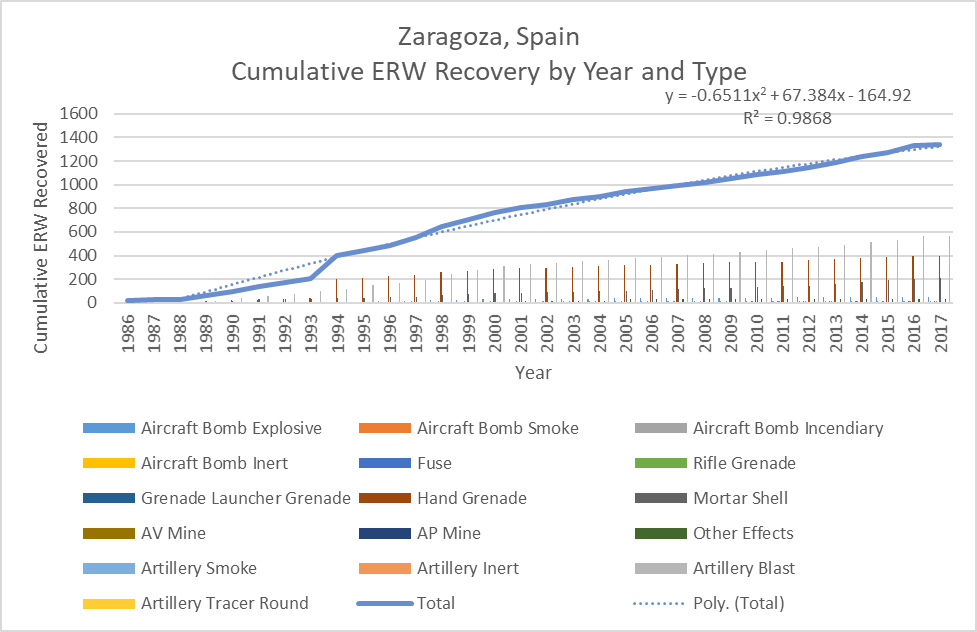
The recovery rates seem to follow a random pattern at first look, failing to demonstrate an obvious decline over time as present in other affected countries. The data is then presented cumulatively (each year showing the total number of munitions recovered to date). This helps absorb some of the outlier incidents, such as when a large cache of munitions is discovered, which tend to skew trend analysis.
The cumulative data appears to show an almost linear increase over time, implying a continuous (and permanent) response rate. A trend line is added to match the total line, using the function with the highest R2 value, most accurately tracing the data set.
Results
In each of the three scenarios the highest R2 value (or best approximation of the data) was actually a polynomial
.
Table 1: Comparison of best-fit curves to data sets based on R2 values

The three models allow for an extrapolation of the data to approximate the recovery rate evolution in specific provinces. The models predict a gradual reduction in recovery rates commensurate with current trends, tapering off at a final summit point. In the model this would represent the discovery and elimination of the last remaining item of ERW in the province.
The estimated end dates (year) for the three provinces can therefore be approximated in the graphs below. Tarragona, exhibiting the most consistent ERW recovery rates, is looking at the longest horizon, whereas Lleida and Zaragoza have final dates much sooner
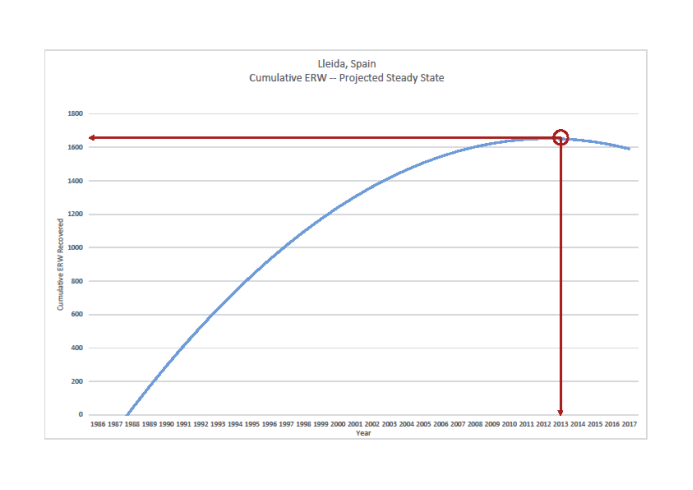
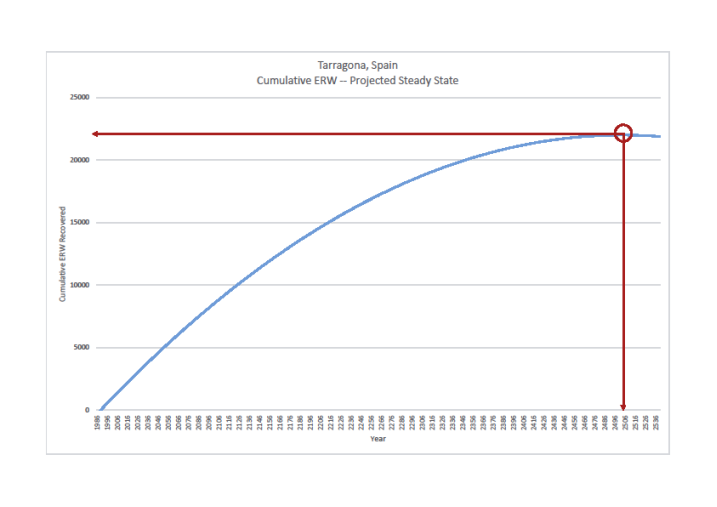
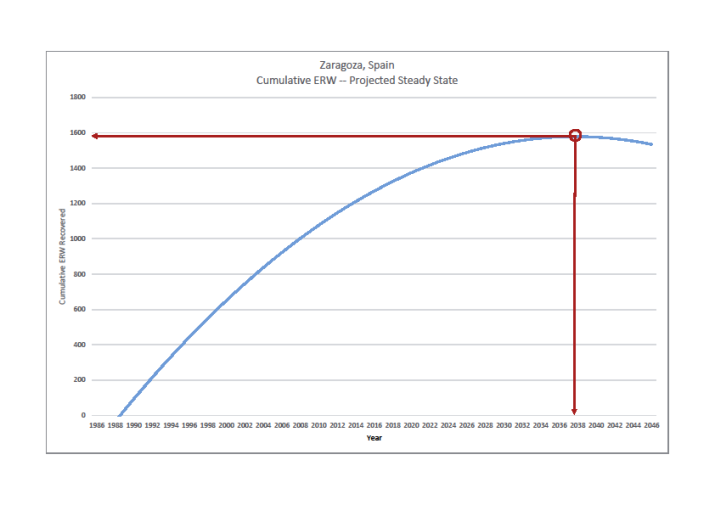
A detailed look demonstrates that while Zaragoza can expect to reach a steady-state (almost no recoveries per year) in twenty years, Tarragona can expect periodic discoveries of ERW for a few hundred years. Lleida should have already achieved this state in 2013, but the raw data show that Lleida has been recovering about twenty items a year for the past decade.
Limitations and Uncertainty
These models therefore do not predict a precise end date to EOD response operations in a territory. Rather, they are indicative of general trends. Further, the use of best fit curves should not give a sense of certainty implied by numbers with seeming great precision. Tarragona, where the curve predicts continuous recovery for hundreds of years, has been recovering just over ten items a year since 2010, whereas Lleida which should have already peaked, is recovering about twenty items a year.
There are several sources of uncertainty in these models, such as obtaining data only as of the mid-1980s, imperfect recording of all events and/or under-reporting. Changes in the legislative landscape, and changes in the socio-economic situation in rural areas are also not considered in this type of modeling. For future force-prediction (size of an EOD team) analysis it is important to take into consideration the evolution of the social context in the regions in which ERW are most frequently found.
Further Research
The data analyzed was not geo-referenced beyond the province level. More accurate position information would be useful in charting the evolution of discovery over time on a map. Further, the data request did not specify information on EOD staffing during this period. The following questions result from the above research.
Spatial mapping and workforce evaluation
What has been the change of workforce size and deployment over time within Spanish EOD? Has it been commensurate with the gradual decrease of ERW discoveries? Where have EOD operations mostly occurred: are they concentrated certain areas? Does this move with time, and can it be correlated to social, economic, political or legal factors?
A separate FOI request could be submitted to assess the evolution of Residual Contamination response in Barcelona province and the city more specifically. This could be compared more directly with bombing data and response evolution in similar situations, namely Dresden, Germany.
Munitions Comparisons
This research did not analyze technical aspects of munition degradation. Spain offers an interesting study in that many of the munitions were prototypes from foreign countries, and were built during (their) peacetime. Other munitions were surplus from the First World War. Manufacturing techniques are noted to vary starkly between war and peacetime, affecting both failure rates and degradation modalities. Further, the placement of specific German testing units in Spain to evaluate the performance of both aircraft and artillery (U-87, Me-109, 88 AA gun, 155 field artillery) is of interest.
Ageing of Munitions
Since the model suggests and experience confirms that munitions will continue to be recovered for the foreseeable future, assessments of risk degradation commensurate with munition decomposition can significantly aid risk management. Studies published by James Madison University GICHD and Fenix Insight all clearly point to several failure modes regarding explosives. The particularity of these failure modes concerning the diverse weaponry used in the Spanish Civil War could offer valuable insight for EOD response and policy.
Conclusion
The “last remaining item” may be treated as an almost unattainable end state, as no true guarantee of 100% zero contamination can be made. It would be beyond the remit of the research to recommend a complete drawdown of response, though a reduction and centralization of main response, with a diffusing of residual capacity can be endorsed, as witnessed in the Spanish example. Municipal police generally are the first to respond and have received basic training in item risk identification, cordoning of an area, and appropriate risk-mitigation procedures.
Spain has been dealing with the consequences of its Civil War for almost 80 years. The response to ERW has evolved from a civil-led, locally oriented one to a professionalized and centralized capacity. For countries emerging from more recent conflict, this highlights that a final zero-ERW position is an unreal expectation, but that processes need be in place to effectively manage risks arising from residual ERW contamination.


